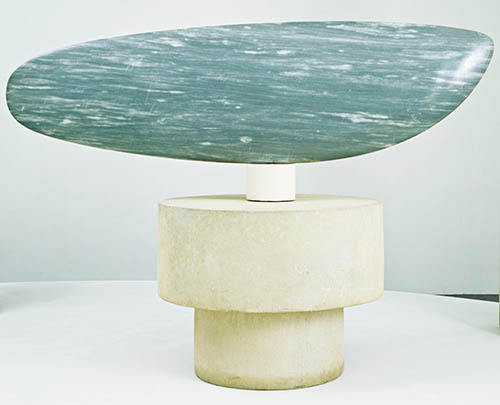CulBeat Express
2018.06.22 12:52
MoMA 콘스탄틴 브란쿠시 조각전(7/22-2/18)
조회 수 806 댓글 0
MoMA PRESENTS FOCUSED EXHIBITION OF CONSTANTIN BRANCUSI’S SCULPTURE
Presentation Also Includes a Selection of Drawings, Photographs, Films, and Archival Material
Constantin Brancusi Sculpture
July 22, 2018–February 18, 2019
MoMA, Floor Two, Paul J. Sachs Galleries

NEW YORK, June 22, 2018—The Museum of Modern Art charts Constantin Brancusi’s
achievements and innovations in sculpture through the focused presentation Constantin
Brancusi Sculpture, on view from July 22, 2018, through February 18, 2019. This
concentrated survey largely comprises MoMA’s holdings of Brancusi’s work, which
demonstrate the artist’s singular approach to materials, among them bronze, stone, and
wood. In this exhibition, 11 sculptures by the artist will be shown together for the first time,
alongside drawings, photographs, and films—extensions of his sculptural endeavors. Also on
view is a selection of archival materials that sheds light on the artist’s working process and his
relationships with friends, sitters, and patrons, including this Museum. Constantin Brancusi
Sculpture is organized by Paulina Pobocha, Associate Curator, with Mia Matthias, Curatorial
Fellow, Department of Painting and Sculpture.
Born in rural Hobiţa, Romania, Brancusi came to art through an immersion in craft; in his
youth he learned direct carving techniques, eventually becoming a skilled woodworker. In
1904 he moved to Paris, where he studied at the École Nationale des Beaux-Arts and then
briefly assisted Auguste Rodin. Brancusi established his own studio at the Impasse Ronsin
soon after and quickly immersed himself in avant-garde art circles. While Rodin and his peers
were making sculpture by modeling clay and casting it in bronze, Brancusi carved his work
directly from sandstone, travertine, and marble, relying on the techniques learned in his
youth. With this method, Brancusi created imaginative and formally reductive works that
evoke rather than resemble the subjects named in their titles.
Although Brancusi made hundreds of sculptures in his lifetime, he limited his subject matter to
people and animals, with just a handful of exceptions. He especially preferred portraits of
women, as seen in Mlle. Pogany and Blond Negress; children’s heads; and birds, exemplified
by Maiastra and Bird in Space. In his work, he pushed sculpture to the threshold of
abstraction. Equally revolutionary was Brancusi’s approach to his sculptures’ pedestals.
Brancusi filled his studio space with functional objects he made himself, such as stools,
fireplaces, benches, as well as pedestals for his sculptures. These pedestals, made from
2
wood, limestone, and marble, became part of the artwork; many were created for specific
sculptures, and some were constructed from existing sculptures. For example, he
incorporated the sculpture Double Caryatid, which depicts two figures, into the base of
Maiastra. On other occasions, Brancusi made pedestals that could support a variety of
sculptures rather than one work in particular. His bases thus performed a dual function,
serving simultaneously as components of the artwork and as their support.
Brancusi’s bases also position the sculpture at a height that references their subject matter.
For example, his Bird in Space works soar high above one’s head, often set on lofty tripartite
bases. His portraits are typically positioned at eye level, and the heads of children and
sleeping women tend to live low to the ground. The unprecedented importance Brancusi
bestowed on his bases transformed sculpture’s relationship to the space it inhabits and, by
extension, to the world at large: If a base is part of the art, what differentiates art from its
surroundings?
In addition to sculpture, Brancusi made drawings, photographs, and films. While he did not
produce many drawings, those he did were executed casually, with whatever materials were
on hand. Brancusi chose subject matter that echoed that of his sculptures, such as his study
related to the no-longer-extant sculpture The First Step. In addition to drawings of women, he
also depicted his sculptures and other objects assembled in his studio.
Brancusi’s relationship to photography, however, was much more deliberate. Similar to his
approach to drawing, he took many photographs of his sculptures, often capturing how they
were installed in his studio. Although some of his photographs are straightforward
representations of his work, many obscure rather than reveal their subjects, as in Self Portrait
in Studio. They mimic the abstracted nature of his sculptural work: the occasionally out-offocus
images emphasize the play of light and shadow on the surfaces of Brancusi’s sculptures.
Brancusi’s least-known experiments, however, unfold in film. With his friend Man Ray, who
introduced him to the medium, Brancusi made films that captured him working with his
materials, activating his artworks through movement, and revealing his sources of inspiration,
such as animals, light in nature, and dance. Although few of Brancusi’s films survive, many of
those that do demonstrate his interest in the movement of objects through space and affirm
his desire for his work to be experienced in the round.





